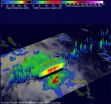(Press-News.org) AMHERST, Mass. – The largest analysis to date of the effect of urbanization on bird and plant species diversity worldwide confirms that while human influences such as land cover are more important drivers of species diversity in cities than geography or climate, many cities retain high numbers of native species and are far from barren environments.
Urban ecologist Paige Warren of the University of Massachusetts Amherst, co-leader of a 24-member research working group at the University of California Santa Barbara's National Center for Ecological Analysis and Synthesis (NCEAS), and colleagues reported their findings recently in Proceedings of the Royal Society B.
"We were able to build the largest database to date from the largest number of cities, more than 140 on every continent except Antarctica," Warren says. "So it's a more global survey than past studies, which have focused mainly on North America and Europe. For the first time, we were able to include cities in South America, in the tropics and in developing countries. This gives us more confidence in our generalizations about what is going on."
"Looking at what drives the number of species found, we see that human factors are more influential than region or where the city is located, for example," she adds. The researchers wrote, "Not surprisingly, greater proportions of intact vegetation in cities, as found in older cities, preserve plant species. These results highlight the importance of including remnant vegetation and restoring natural areas in the design of cities."
Thus, the study underlines the value of urban green space as refuges for native species and migrating birds, Warren says. Conserving green spaces, restoring native plant species and adding habitats that promote biodiversity in cities can support more bird and plant species.
Working group members compiled the global dataset for birds in 54 cities and for plants in 110 cities. The majority of urban bird and plant species they found are native, they write, and cities even support populations of 36 threatened bird and 65 threatened plant species.
But across the study, cities supported about 92 percent fewer bird species and 75 percent fewer native plant species than expected for similar undeveloped lands, a "substantial decline" that is best explained by human-built features such as land cover and city age. The working group found that cities with more natural habitats support more bird and plant species and experience fewer species losses as the city grows.
The most common "cosmopolitan" bird species, occurring in more than 80 percent of cities, were the rock pigeon, house sparrow, starling and barn swallow. Among plants, 11 species including annual meadow grass occur in more than 90 percent of cities.
One of Warren's co-leaders and the paper's lead author, Myla F.J. Aronson of Rutgers, points out that "while urbanization has caused cities to lose large numbers of plants and animals, the good news is that cities still retain endemic native species, which opens the door for new policies on regional and global biodiversity conservation."
Networking since 2010, the researchers recently received a five-year National Science Foundation grant to fund a global network called UrBioNet to support urban biodiversity research and practice. Among other goals, they hope to expand databases to include more cities with rapid urban growth and less available data in such places as Africa, South America and Southeast Asia, and to develop recommendations for monitoring biodiversity in urban areas.
INFORMATION:
Global survey of urban birds and plants find more diversity than expected
2014-03-11
ELSE PRESS RELEASES FROM THIS DATE:
Diets high in animal protein may help prevent functional decline in elderly individuals
2014-03-11
A diet high in protein, particularly animal protein, may help elderly individuals function at higher levels physically, psychologically, and socially, according to a study published in the Journal of the American Geriatrics Society.
Due to increasing life expectancies in many countries, increasing numbers of elderly people are living with functional decline, such as declines in cognitive ability and activities of daily living. Functional decline can have profound effects on health and the economy.
Research suggests that aging may reduce the body's ability to absorb or ...
Substance naturally found in humans is effective in fighting brain damage from stroke
2014-03-11
DETROIT – A molecular substance that occurs naturally in humans and rats was found to "substantially reduce" brain damage after an acute stroke and contribute to a better recovery, according to a newly released animal study by researchers at Henry Ford Hospital.
The study, published online before print in Stroke, the journal of the American Heart Association, was the first ever to show that the peptide AcSDKP provides neurological protection when administered one to four hours after the onset of an ischemic stroke.
This type of a stroke occurs when an artery to the brain ...
NASA eyes 2 tropical cyclones east of Australia
2014-03-11
NASA's Aqua and TRMM satellites have been providing rainfall data, cloud heights and temperature and other valuable information to forecasters at the Joint Typhoon Warning Center as they track Tropical Cyclones Hadi and Lusi in the South Pacific.
NASA's Aqua satellite captured both storms in one infrared image on March 10 at 14:47 UTC/10:47 a.m. EST. At that time, Hadi was near the east Queensland coast while Lusi was several hundred miles north of New Caledonia. The Atmospheric Infrared Sounder or AIRS instrument captured infrared data that was used to create a false-colored ...
Alps to Appalachia; submarine channels to Tibetan plateau; Death Valley to arctic Canada
2014-03-11
Boulder, Colo., USA – On 27 Feb. and 6 Mar. 2014, GSA Bulletin published 11 articles online ahead of print, including two that are open access: "O2 constraints from Paleoproterozoic detrital pyrite and uraninite" and "Sediment transfer and deposition in slope channels: Deciphering the record of enigmatic deep-sea processes from outcrop." Other articles cover geological features in the Alps; the Appalachians; Death Valley; India; the Himalaya; the Columbia River Basalt Province; San Simeon, California; Kaua'i, Hawai'i; and artic Canada.
GSA Bulletin articles published ...
Scientists from Penn and CHOP confirm link between missing DNA and birth defects
2014-03-11
In 2010, scientists in Italy reported that a woman and her daughter showed a puzzling array of disabilities, including epilepsy and cleft palate. The mother had previously lost a 15-day-old son to respiratory failure, and the research team noted that the mother and daughter were missing a large chunk of DNA on their X chromosome. But the researchers were unable to definitively show that the problems were tied to that genetic deletion.
Now a team from the University of Pennsylvania and The Children's Hospital of Philadelphia has confirmed that those patients' ailments ...
Lessons learned managing geriatric patients offer framework for improved care
2014-03-11
A large team of experts led by a Johns Hopkins geriatrician reports that efforts to improve the care of older adults and others with complex medical needs will fall short unless public policymakers focus not only on preventing hospital readmission rates, but also on better coordination of community-based "care transitions." Lessons learned from managing such transitions for older patients, they say, may offer a framework for overall improvement.
Nationwide, some 22 percent of older adults experience so-called care transitions annually, moving from and among hospitals, ...
Change happens: New maps reveal land cover change over 5 years across North America
2014-03-11
This news release is available in French and Spanish. Montreal, 11 March 2014—A new set of maps featured in the CEC's North American Environmental Atlas depicts land cover changes in North America's forests, prairies, deserts and cities, using satellite images from 2005 and 2010. These changes can be attributed to forest fires, insect infestation, urban sprawl and other natural or human-caused events. Produced by the North American Land Change Monitoring System (NALCMS), a trinational collaborative effort facilitated by the CEC, these maps and accompanying data can ...
AGU journal highlights -- March 11, 2014
2014-03-11
The following highlights summarize research papers that have been recently published in Geophysical Research Letters (GRL), Journal of Geophysical Research-Atmospheres (JGR-D), and Journal of Geophysical Research-Earth Surface (JGR-F).
In this release:
Cassini sheds light on Titan's second largest lake, Ligeia Mare
Tectonic stress feedback loop explains U-shaped glacial valleys
Measuring the effect of water vapor on climate warming
First assessment of noctilucent cloud variability at midlatitudes
Modeling surface circulation patterns in the Gulf of Mexico
New ...
Ocean food web is key in the global carbon cycle
2014-03-11
(Santa Barbara, Calif.) — Nothing dies of old age in the ocean. Everything gets
eaten and all that remains of anything is waste. But that waste is pure gold to
oceanographer David Siegel, director of the Earth Research Institute at UC Santa
Barbara.
In a study of the ocean's role in the global carbon cycle, Siegel and his colleagues used those nuggets to their advantage. They incorporated the lifecycle of phytoplankton
and zooplankton — small, often microscopic animals at the bottom of the food chain —into a novel mechanistic model for assessing the global ocean carbon ...
Lack of sleep, stress describe a mother's experience after child's ALL treatment
2014-03-11
"It's a whole new cancer world" and "I don't remember what it's like to have sleep" were the most common themes of mothers interviewed by University of Colorado Cancer Center researchers during the maintenance period after a child's treatment for acute lymphoblastic leukemia (ALL). Results of this qualitative study are published in a recent issue of the Journal of Pediatric Nursing. A second study, published today in the Journal of Pediatric Oncology Nursing, shows the quantitative differences between stress, anxiety and depression in these parents of chronically ill children ...


